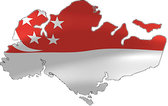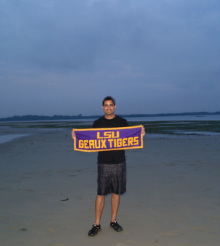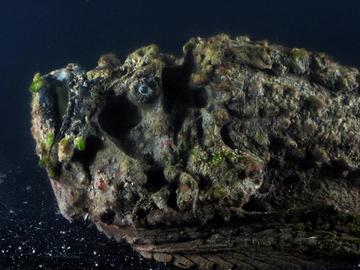 Back in July, Prosanta Chakrabarty and I were invited to participate in the comprehensive marine biodiversity workshop in Singapore hosted by the National University of Singapore. This workshop was to be a collaborative effort, bringing in professionals from all over the world to examine everything from fishes and shrimps, to marine mites and nematodes. After figuring out all of the logistics I found myself boarding an extremely long flight to Singapore last month. Although I wasn't exactly sure what to expect out of the workshop, I can happily say that I think the workshop was overall a success, as we found and cataloged a large variety of species along the Singapore coastline.  Prosanta at Chek Jawa The focus of this particular workshop was the Johore Strait, which borders the northern part of Singapore and separates it from Malaysia. While most of Singapore is a developed metropolis, we were fortunate enough to stay on the island of Palau Ubin for the duration of the workshop, which is a smaller, forested island with little development. On this island there is an Outward Bound School that graciously let us use their dorms and provided us with adequate lab space, and also fed us during the trip. It was also the perfect launching point for all of our excursions around Palau Ubin and the coastline of of Singapore adjacent to the Johore Strait. The fish people involved on this trip included myself and Prosanta Chakrabarty from LSU, goby expert Helen Larson from Australia, and Ng Heok Hee, Tan Heok Hui, Zeehan Jaafar and Kelvin Lim Kok Peng from the Raffles Museum of Biodiversity Research at NUS. Throughout the trip we sampled in mudflats, mangroves, sandy beaches, seagrass beds, and also trawled and dredged the deeper parts of the strait on the RV Galaxea to cover as many habitat types as we could.  Hollow-cheeked stonefish (Synanceja horrida). Photo credit Arthur Anker Each day we would split up and sample different sites to maximize our coverage of the area. Everyone would then later meet up in the lab to identify and sort the samples. Samples were then photographed by shrimp expert and macro photographer Arthur Anker (check out his Flickr account), tissued and preserved for museum collections either at Raffles, in Australia, or here at LSU. Overall we collected over 200 different fish species and added approximately 600 tissue samples to our LSU collection. I cannot thank enough all of the amazing people that made this trip possible, and would like to extend my thanks to all of the organizers, volunteers, and other workshop participants that helped me during this excursion. Hopefully one day soon I'll be able to re-visit Singapore and explore the surrounding oceans again for more fish. Comments are closed.
|
Archives
August 2021
Categories |